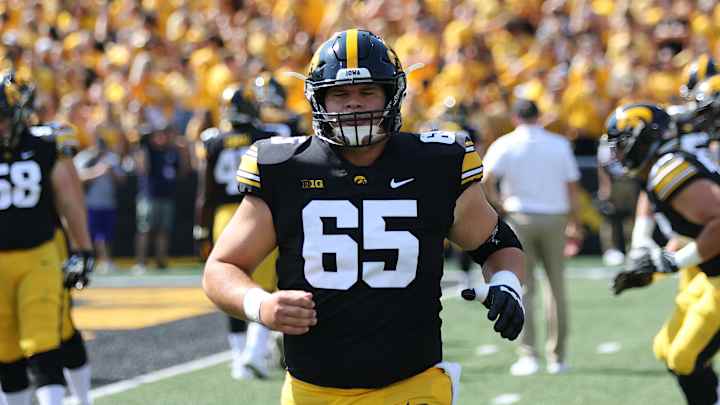Looking at Iowa Football's Consensus All-Americans

IOWA CITY, Iowa - The Stew and LeNore Hansen Football Performance Center was opened in 2014.
Inside the $55 million home to Iowa football is the all-American Room. The team eats breakfast and dinner there. It’s also where Coach Kirk Ferentz holds his weekly Tuesday sessions with the media during the season.
One wall in that room tells part of the story of Iowa football. It’s where portraits of the Hawkeyes’ consensus all-Americans hang. Wall space is quickly becoming an issue. Center Tyler Linderbaum’s portrait will soon go up on that wall. The junior from Solon was named a first-team all-American by the Associated Press on Monday, giving him consensus all-America status.
Linderbaum became the 28th Hawkeye to earn that distinction, and the 13th player from the Ferentz era. A Hawkeye has now earned consensus all-America laurels three seasons in a row and four seasons in the last five, both unprecedented milestones for the program. Linderbaum walks in the fresh footsteps of Daviyon Nixon (2020), Keith Duncan (2019) and Josey Jewell and Josh Jackson (2017).
Coach Hayden Fry had eight all-Americans under his 20-year watch (linebacker Larry Station was a two-time pick). Iowa football had produced eight all-Americans in its history before Fry arrived in 1979.
The 13 all-Americans he’s coached paint another portrait of Iowa football under Ferentz. Five played offense, six played defense and two were special teams standouts. Four changed positions once they got to Iowa, and a fifth never played the position Ferentz thought he would. The list includes a junior college transfer and a player who sat out his junior season and got his academic work in order at a junior college.
One received his scholarship offer from Iowa just hours before signing day. Two more came as walk-ons. Nine of the 13 won distinguished national awards during their careers, and the other four were finalists for elite awards.
Six of the 13 are native Iowans. That includes Ferentz’s first consensus all-American, tight end Dallas Clark. He arrived on campus as a walk-on linebacker. He left as the Mackey Award winner as the nation’s top tight end in 2002 and a first-round NFL Draft pick. He made the position change during spring ball in 2001. Among his spoils is a Super Bowl ring with the Indianapolis Colts.
Joining Clark as another consensus all-American in 2002 was guard Eric Steinbach. He arrived at Iowa as a prep all-America tight end, then overcame injuries to be a two-time all-Big Ten selection. He got that award as a junior even though he played in just nine games because of an elbow injury.
That 2002 offensive line, and Clark, helped quarterback Brad Banks earn the Associated Press National Player of the Year Award and the Davey O’Brien Award. They also helped the Hawkeyes win a Big Ten title, and paved the way for the Big Ten’s No. 1 offense. After a 62-10 victory over Northwestern in the 2002 regular-season home finale, Steinbach and fellow senior offensive linemen David Porter, Bruce Nelson, Andy Lightfoot and Ben Sobieski left the game holding hands.
“We all just grabbed hands because we’ve got such unity,” Steinbach said of a team that would finish 11-2 and finish the season ranked No. 8 nationally.
Robert Gallery came to Iowa as a tight end, and had three catches for 52 yards as a freshman in 2000 when his career took a detour. With Steinbach out with an ankle injury and big bodies hard to find in Ferentz’s second season as coach, he moved Gallery to offensive tackle before the fifth game against Indiana.
“Robert is a team guy all the way and he agreed to the move,” Ferentz said. Gallery, from Masonville, went on to earn consensus all-America honors in 2003 and was named winner of the Outland Trophy that goes to the nation’s top interior lineman. The Big Ten’s offensive lineman of the year was also the second pick of the 2004 NFL Draft by the Oakland Raiders.
Joining Gallery as a consensus all-American in 2003 was Iowa City’s own Nate Kaeding, who would go on to become one of the most accurate field-goal kickers in NFL history. Kaeding won the Lou Groza Award in 2002, when he made 21 of 24 field goals for the Hawkeyes. He was even better as a senior, making 20 of 21 field goals. But he was only a Groza finalist in 2003.
Five years later, Shon Greene became the program’s first consensus all-American at running back since Heisman Trophy winner Nile Kinnick in 1939. Greene had seen limited duty in his first two seasons, with 37 carries for 173 yards and a touchdown in 2005 and 32 carries for 205 yards and a touchdown in 2006. He spent 2007 at Kirkwood Community College in Cedar Rapids getting his academic life in order, then returned for a record-setting 2008 season. Greene rushed for a school-record 1,850 yards and 20 touchdowns. He was the only player in the nation to rush for at least 100 yards in every game. That included 217 yards against Wisconsin and 211 against Purdue.
Greene won the Doak Walker Award as the nation’s top running back, as well as the Chicago Tribune Silver Trophy that went to the Big Ten’s most valuable player. He was also named the league’s most valuable offensive player and finished sixth in Heisman Trophy balloting. Adrian Clayborn joined the distinguished list in 2010 at defensive end, finishing his career with 192 tackles, 19 sacks and a memorable blocked punt that he returned for a 53-yard fourth-quarter touchdown at Penn State in 2009. He also became a first-round NFL Draft pick (No. 20 to Tampa Bay). As a senior, Clayborn was a finalist for both the Lombardi Award and the Ted Hendricks Award.
Brandon Scherff was a potential first-round draft pick in 2013, but he decided to return to Iowa for what would become a memorable 2014 season. The offensive tackle from Denison won the Outland Trophy, was a consensus first-team all-American and was named the Big Ten’s top offensive lineman.
A quarterback as a sophomore at Denison, Scherff started his career at Iowa as a guard before moving to tackle as a sophomore. Scherff was selected by Washington with the fifth pick of the 2015 NFL Draft.
When Desmond King came to Iowa in 2013, Ferentz thought he would become a safety. “Shows you how smart I am,” Ferentz said.
King was thrown into the fire at cornerback as a freshman in 2013, against Northern Illinois. Jordan Lomax injured a hamstring in that season opener, and King was next man in. King remained a starter at cornerback for the rest of his career.
He won the Jim Thorpe Award and Jack Tatum Award as a junior in 2015, when he had eight of his 14 career interceptions. He was also a finalist for the Walter Camp Award, and named the top defensive back in the Big Ten. King was a finalist for the 2016 Thorpe Award as well. Jackson earned consensus all-America honors and was also honored as the best defensive back in the Big Ten in 2017, when he matched King’s eight interceptions. He won the Jack Tatum Award and was a finalist for the JimThorpe Award.
Jewell, a linebacker from Decorah, joined Jackson as a consensus all-American in 2017. He made the most of his last-second scholarship offer, which came after assistant coach Reese Morgan finally convinced Ferentz to take him.
Jewell was a finalist for the Butkus Award that goes to the nation’s best linebacker as a junior in 2016, then was named the Big Ten’s defensive player of the year and linebacker of the year the following season. He also won the Lott IMPACT Trophy in 2017. Jewell finished with 433 career tackles, and 13.5 of his 28 career tackles for a loss came as a senior.
After kicking as a freshman in 2017, Duncan lost his job to Miguel Recinos the next two seasons.. But instead of packing his bags and looking for a new home, he stuck it out and became a consensus all-American as a junior in 2019 when he made an NCAA-best 29 field goals in 34 attempts. He was a finalist for the Lou Groza Award and the Big Ten’s kicker of the year. Duncan backed that up by making 14 of 18 field goals as a senior. Nixon, who started his career at Iowa Western of Council Bluffs, made the most of his only season as a starter at Iowa. He was a consensus all-American in 2020, and named the Big Ten’s defensive player of the year and defensive lineman of the year.
Nixon was a finalist for both the Outland Trophy and the Bronco Nagurski Award. And like Clayborn, his shining moment came at Penn State. He picked off a Sean Clifford pass, split two defenders with a move that defied his 304 pounds and went 71 yards untouched for a touchdown in the 41-21 victory.
Linderbaum started his career as a defensive tackle, but Ferentz moved him to center and he’s started 34 consecutive games there heading into the Jan.1 Citrus Bowl matchup with Kentucky. In addition to being named the Big Ten’s best center and the offensive lineman of the year, Linderbaum became the first Hawkeye to win the Rimington Award that goes to the nation’s top center. He was also a finalist for the Outland Trophy and the Lombardi Award. Linderbaum is one of 13 players who have reached the pinnacle of college football during the Ferentz era as a consensus all-American. Thirteen unique success stories. Thirteen different paths to glory.
